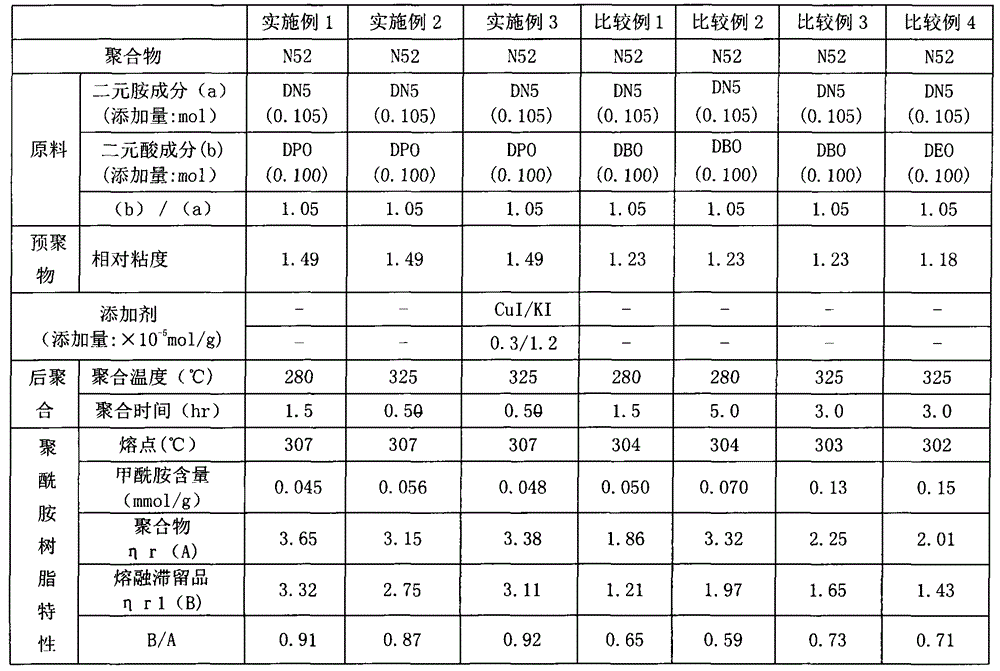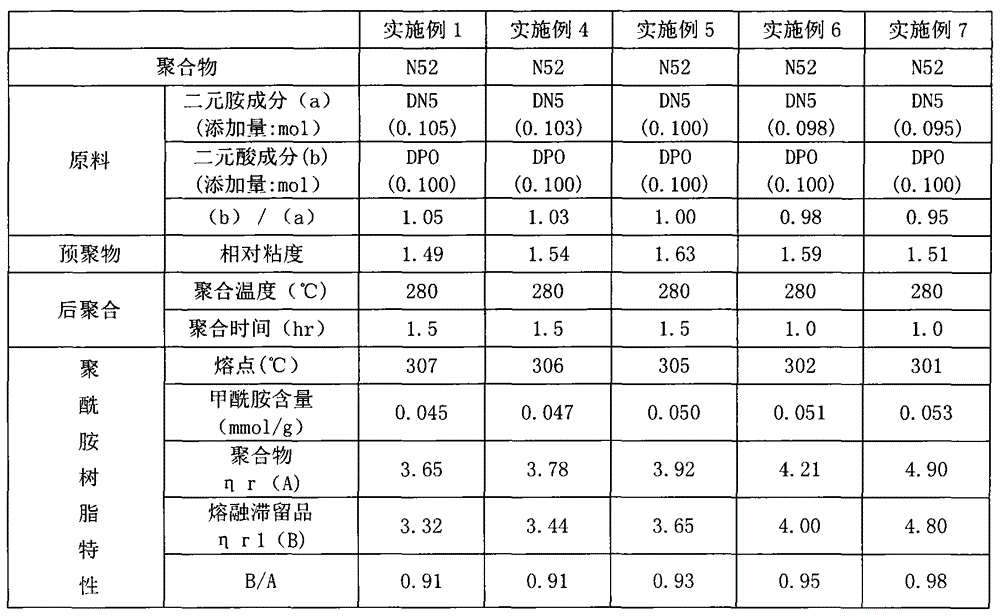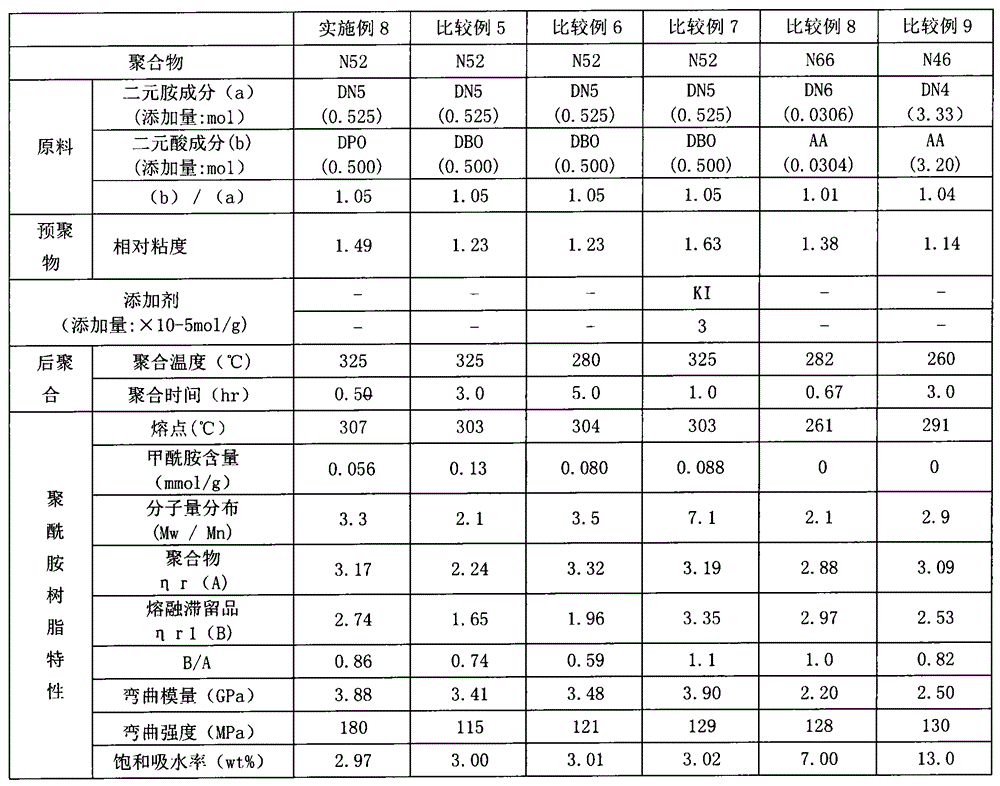Polyamide resin and preparation method thereof
A polyamide resin and diamine technology, which is applied in the field of polyamide resin and its manufacturing, can solve the problems of poor melt retention stability, no improvement in relative viscosity, and decrease in viscosity of polyoxamide resin.
- Summary
- Abstract
- Description
- Claims
- Application Information
AI Technical Summary
Problems solved by technology
Method used
Image
Examples
Embodiment 8
[0092] Injection molding temperature: 310°C (Example 8, Comparative Examples 5-7)
[0093] 270°C (comparative example 8)
[0094] 295°C (comparative example 9)
[0095] Mold temperature: 130°C (Example 8, Comparative Examples 5-7)
[0096] 80 (comparative example 8)
[0097] 90°C (comparative example 9)
[0098] Test piece: length 64mm×width 12.7mm×thickness 3.0mm
[0099] Bending performance test equipment: AG-IS-20KN (SHIMAZU)
[0100] (7) Saturated water absorption at 23°C
[0101] The polyamide resin is hot-pressed into a film at a temperature of melting point + 20°C, and rapidly cooled in ice water. The thickness of the sample is 0.1-0.5mm (50mm*50mm). The sample was immersed in water at 23°C to a constant weight and weighed (W1), and then the sample was vacuum-dried at 100°C to a constant weight and weighed (W2). Calculate water absorption (%)=100*(W1-W2) / W2.
[0102] Abbreviation description:
[0103] DN4: 1,4-butylene diamine, DN5: 1,5-pentanediamine, DN6: 1,6...
Embodiment 1
[0115] The three-necked flask (500ml) was first purged with nitrogen for 15 minutes, and then a certain nitrogen flow was maintained. Toluene (300 ml) and DPO (24.22 g, 0.100 mol) were added to the three-necked flask, followed by stirring and raising the temperature to 70°C. After DPO was completely dissolved in toluene at 70°C, DN5 (10.73 g, 0.105 mol) was added to the system, then the temperature was raised to 130°C, and the reaction was refluxed for 1 hour. This is followed by filtration and washing, followed by drying in a vacuum oven at 100°C for 12 hours. The relative viscosity of the obtained prepolymer was 1.49.
[0116] Feed 2.00 g of the obtained prepolymer into a glass test tube with a diameter of 19 mm, then replace it with nitrogen for 5 times, then reduce the pressure of the system to below 300 Pa, and then place it in a metal bath at 280 ° C for post-polymerization React for 1.5 hours. Polymer properties are in Table 1.
Embodiment 2
[0118] The preparation method of prepolymer is identical with embodiment 1,
[0119] Take 2.00 g of the obtained prepolymer and feed it into a glass test tube with a diameter of 19 mm, then replace it with nitrogen for 5 times, then reduce the pressure of the system to below 300 Pa, and then place it in a metal bath at 325 ° C for post-polymerization React for 0.5 hours. Polymer properties are in Table 1.
PUM
| Property | Measurement | Unit |
|---|---|---|
| particle size | aaaaa | aaaaa |
Abstract
Description
Claims
Application Information
 Login to View More
Login to View More - R&D
- Intellectual Property
- Life Sciences
- Materials
- Tech Scout
- Unparalleled Data Quality
- Higher Quality Content
- 60% Fewer Hallucinations
Browse by: Latest US Patents, China's latest patents, Technical Efficacy Thesaurus, Application Domain, Technology Topic, Popular Technical Reports.
© 2025 PatSnap. All rights reserved.Legal|Privacy policy|Modern Slavery Act Transparency Statement|Sitemap|About US| Contact US: help@patsnap.com



